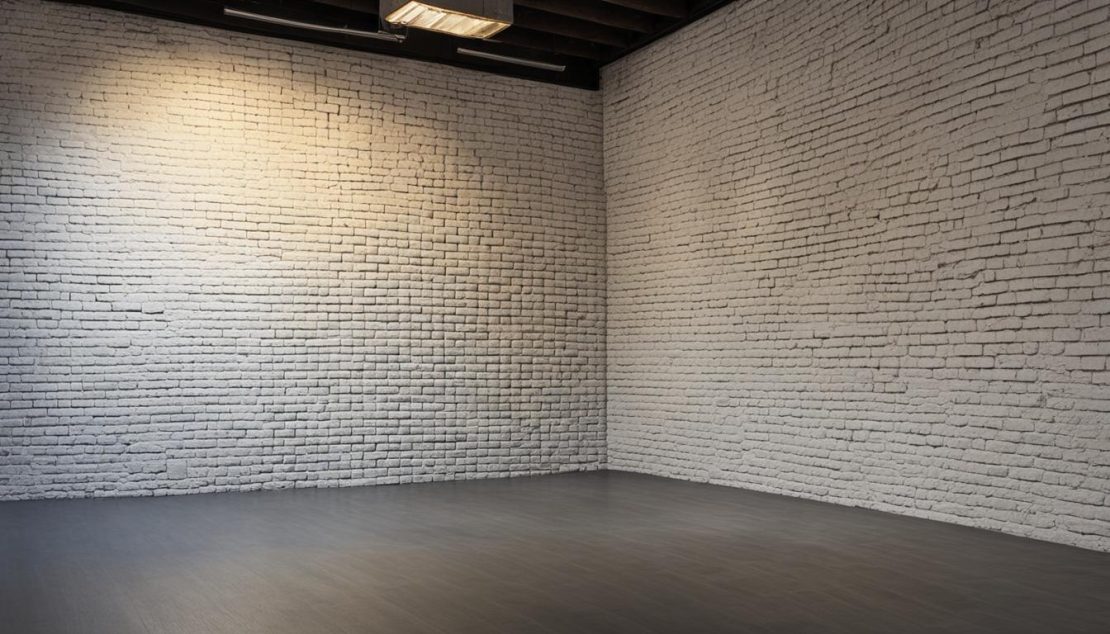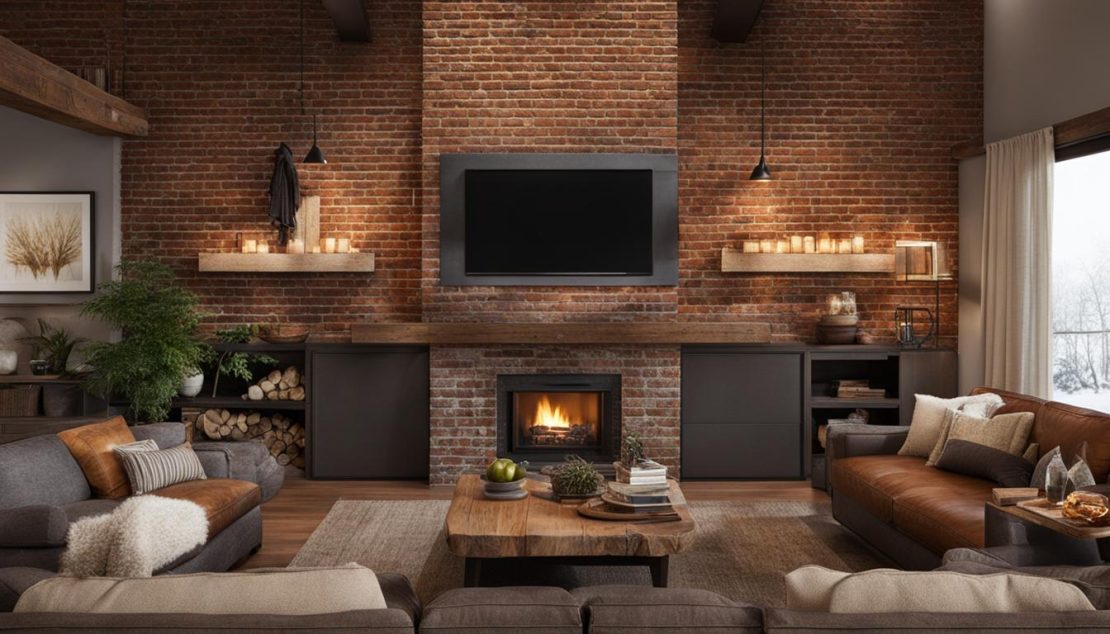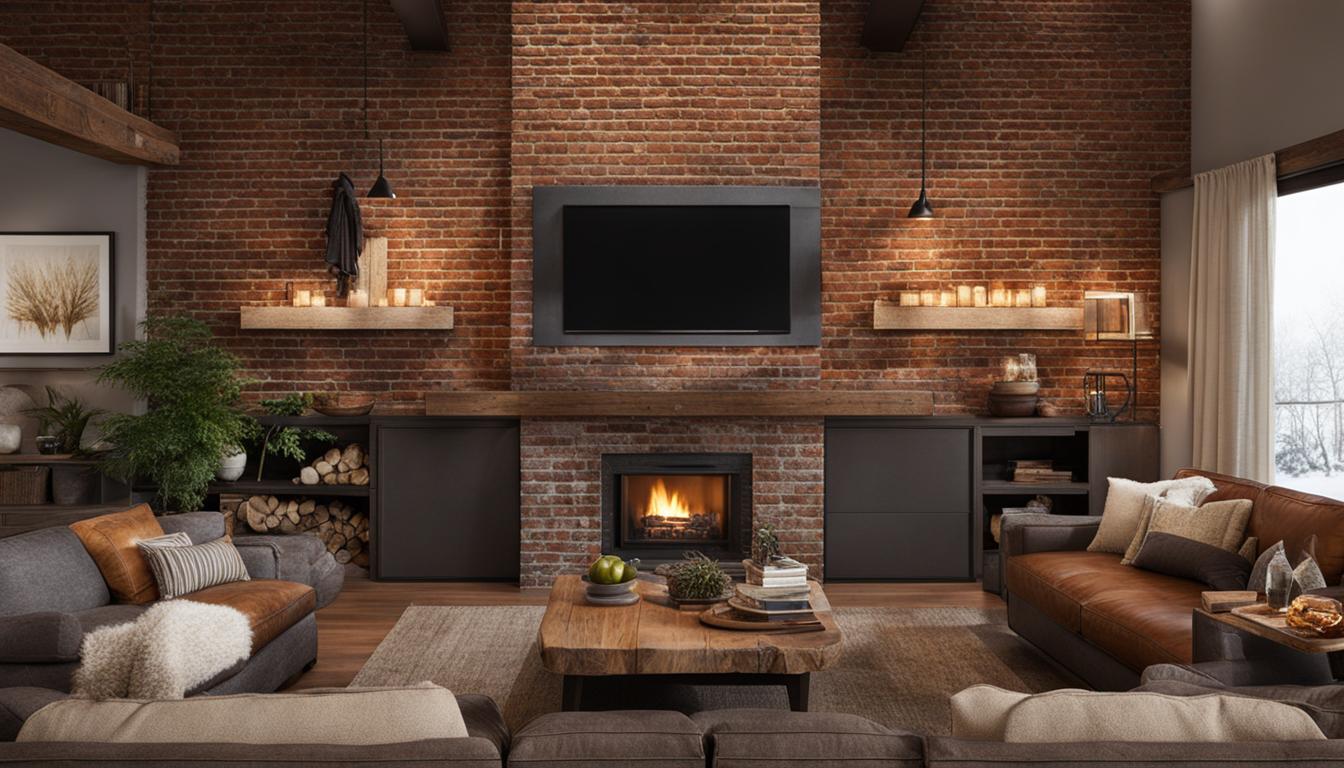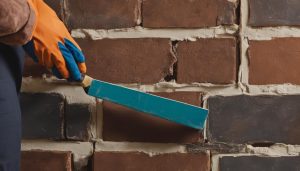If you’re looking for a way to refresh the look of your space, consider painting your interior brickwork. Whether you have a brick wall interior or exposed brick, a fresh coat of paint can bring new life to your home decor. In this section, we’ll explore expert tips and techniques for transforming your interior brick walls into a modern masterpiece.

Create an image of a blank interior space with yellowish brick walls. The walls have been painted white, but some areas still show the original brick color underneath. Shadows cast by overhead lighting add depth and dimension to the space. There are no visible windows or doors, giving a sense of privacy and seclusion.
Interior brickwork is a classic feature in many homes and can add a unique charm to any room. However, if you’re ready for a change, painting your bricks can be a cost-effective solution. Not only can it modernize the look of your space, but it can also serve as an excellent backdrop for your decor. Throughout this section, we’ll share our knowledge of brick painting to help you achieve your desired look.
Design and Preparation for Painting Interior Brickwork
Before you start painting your interior brickwork, it’s important to consider the overall design and prepare the surface properly for optimal results. The following design ideas and installation techniques for brickwork will guide you through the necessary steps:
- Consider choosing a complementary color palette that enhances the existing decor of your space or creates a new design statement.
- For rustic charm, consider leaving some of the brick exposed and painting just the mortar lines.
If you’re planning on installing new brickwork, be sure to choose a brick that complements the overall aesthetic of your space. Brick comes in a variety of colors, sizes, and styles, so careful consideration will ensure optimal design results.
Once you’ve determined your design choices, it’s time to prepare the surface. Follow these steps to properly prepare the brickwork surface:
- Clean the brickwork with a wire brush or pressure washer to remove any loose debris and dirt. Allow the surface to dry completely before proceeding to the next step.
- Fill in any cracks or gaps in the mortar lines with a mortar repair compound, according to the manufacturer’s instructions.
- If the brickwork has been previously painted, you may need to remove the paint or apply a primer to ensure the new paint will adhere properly.
- Apply a primer if needed to ensure better adhesion and an even finish. Allow the primer to dry completely before proceeding to the next step.
Proper design choices and surface preparation are crucial for ensuring optimal results when painting interior brickwork. The following table offers an overview of some popular brickwork design ideas and techniques:
| Design Idea | Description |
|---|---|
| Exposed Brickwork | For a natural, rustic feel, leave the brick exposed and paint the mortar lines. This technique adds warmth and texture to any interior. |
| Color Wash | A color wash allows the natural texture of the brick to show through while still adding a wash of color. This technique is ideal for creating a subtle yet elegant impact. |
| Whitewash | A white brick wall can brighten a space and create an airy, light-filled atmosphere. This technique works especially well in smaller spaces, adding a feeling of openness and tranquility. |
| Graphic Statement | With the use of painter’s tape and a template, it’s possible to create graphic, geometric shapes on interior brickwork. This technique adds a modern, unexpected element to any room. |
In the next section, we’ll explore various paint options suitable for brick surfaces and explain how to choose the right paint and color for your interior brickwork.
Choosing the Right Paint and Color for Interior Brickwork
Choosing the appropriate paint and color for your interior brickwork is crucial to achieving the desired look for your space. A fresh coat of paint can enhance the overall appeal of your brick walls and complement your interior design.
When selecting the paint for your brickwork, it’s important to opt for a paint that is formulated specifically for masonry surfaces. Using regular wall paint can lead to peeling and flaking over time, so it’s best to invest in the appropriate paint.
Matte and low-sheen finishes are suitable for interior brick walls as they provide a subtle, elegant look and don’t reflect light excessively. On the other hand, glossy finishes are not recommended as they can highlight surface imperfections.
When it comes to choosing the color for your brickwork, the possibilities are endless. Consider the color scheme of your interior design and choose a shade that complements it. If you prefer a subtle look, opt for shades of white or gray. Alternatively, if you want to make a statement, consider bolder colors such as blue or green.
Moreover, the color you choose can also impact the room’s ambiance. Warm colors like red and orange can create a cozy, inviting atmosphere, while cooler tones like blue and green can create a calm, relaxing environment.
Brickwork Interior Design
The color of your brickwork can have a significant impact on the overall design of your space. Consider creating a color scheme that complements the rest of your décor, or use your brickwork as the focal point and design the rest of the space around it.
An interesting way to incorporate brickwork into your interior design is by creating an accent wall using brick. An accent wall can add depth and texture to your space, and draw attention to specific areas of the room.
Whatever color or design you choose, remember that your interior brickwork is a unique feature that can add character and charm to your space.

Create an image of a cozy living room with exposed brick walls painted in a warm, earthy tone. The bricks should have a textured and weathered appearance, with natural variations in color. The room should have plenty of natural light and be decorated with comfortable, rustic furnishings, such as a worn leather sofa and fluffy knit blankets. A crackling fireplace should be the centerpiece of the room, adding to the cozy atmosphere.
Painting Techniques for Interior Brickwork
Now that you have prepared the surface and selected your paint, it’s time to dive into painting techniques for your interior brickwork. With the right techniques, you can achieve an even, professional-looking finish that will enhance the beauty of your brick walls.
Brush or Roller?
One of the most commonly asked questions when it comes to painting interior brickwork is whether to use a brush or roller. The answer? It largely depends on the size of the area you are painting. For small areas or hard-to-reach spots, a brush is the best choice. For larger areas, a roller can help you cover more surface area in less time.
Mortar Lines
Dealing with mortar lines can be tricky when painting interior brickwork. One technique is to use a smaller brush to carefully paint around the lines. Another approach is to apply a base coat with a roller and then use a brush to fill in the gaps. Whichever technique you choose, take your time and work carefully to avoid any excess paint or drips.
Maximizing Coverage
To maximize coverage, work in small sections and use a circular motion when applying the paint. Start at the top of the wall and work your way down, blending each new section with the previous one to avoid visible seams. If you notice any drips or streaks, immediately wipe them away with a clean cloth to ensure a smooth finish.
With these expert techniques, you can achieve the perfect painted finish for your interior brickwork. Take your time, work carefully, and enjoy the stunning transformation of your space.
Finishing Touches and Maintenance for Painted Interior Brickwork
Now that you’ve successfully painted your interior brickwork, it’s essential to ensure that it remains in great condition. We’ve put together a few tips for finishing touches and maintenance practices that will help you keep your painted interior brick walls looking beautiful for years to come.
Properly Seal the Paint
One of the most important steps in maintaining your painted interior brickwork is properly sealing the paint. Applying a sealant will help protect the paint from wear and tear, as well as make it easier to clean and maintain. Make sure to choose a high-quality sealant that is specifically formulated for masonry. Apply the sealant with a brush or roller and follow the manufacturer’s instructions closely.
Maintain the Appearance
Regularly cleaning your painted interior brickwork is crucial in maintaining its appearance over time. Use a soft-bristled brush or cloth to remove any dirt or dust, and avoid using harsh chemical cleaners that can damage the paint. If you notice any chips or scratches in the paint, touch them up with a small brush and a matching paint color to keep your walls looking their best.
Consider Brickwork Renovation
If your interior brickwork is in need of a more extensive makeover, consider a professional brickwork renovation. This can involve repairing any damages, applying a fresh coat of paint, or even completely changing the design or layout of your brick walls. A renovation can help enhance the beauty and value of your home while also addressing any underlying structural issues.
Wrap Up
Now you have the knowledge and techniques to transform your interior brickwork into a modern masterpiece. Don’t be afraid to get creative with your design ideas and color choices. Remember that proper preparation, paint selection, and painting techniques are essential for achieving a professional-looking finish.
Finally, don’t forget to maintain your painted interior brickwork. Regular cleaning and touch-ups can go a long way in preserving its appearance and extending its lifespan. So go ahead and embrace the unique charm of interior brickwork while enjoying the benefits of a personalized aesthetic.




